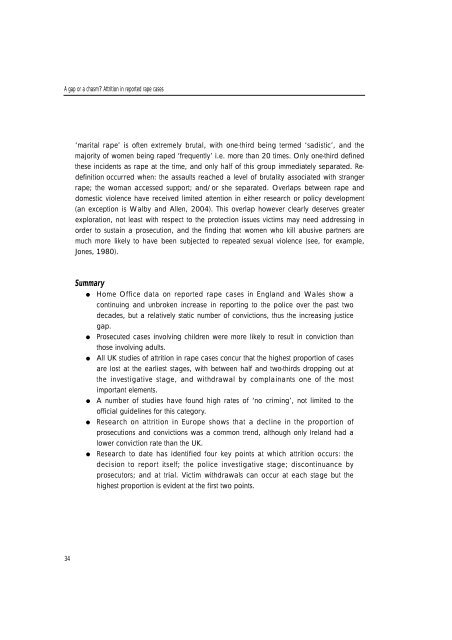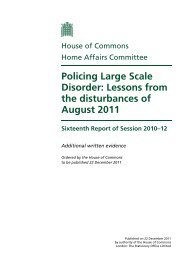A gap or a chasm? - National Police Library Online Catalogue
A gap or a chasm? - National Police Library Online Catalogue
A gap or a chasm? - National Police Library Online Catalogue
You also want an ePaper? Increase the reach of your titles
YUMPU automatically turns print PDFs into web optimized ePapers that Google loves.
A <strong>gap</strong> <strong>or</strong> a <strong>chasm</strong>? Attrition in rep<strong>or</strong>ted rape cases<br />
34<br />
‘marital rape’ is often extremely brutal, with one-third being termed ‘sadistic’, and the<br />
maj<strong>or</strong>ity of women being raped ‘frequently’ i.e. m<strong>or</strong>e than 20 times. Only one-third defined<br />
these incidents as rape at the time, and only half of this group immediately separated. Re-<br />
definition occurred when: the assaults reached a level of brutality associated with stranger<br />
rape; the woman accessed supp<strong>or</strong>t; and/<strong>or</strong> she separated. Overlaps between rape and<br />
domestic violence have received limited attention in either research <strong>or</strong> policy development<br />
(an exception is Walby and Allen, 2004). This overlap however clearly deserves greater<br />
expl<strong>or</strong>ation, not least with respect to the protection issues victims may need addressing in<br />
<strong>or</strong>der to sustain a prosecution, and the finding that women who kill abusive partners are<br />
much m<strong>or</strong>e likely to have been subjected to repeated sexual violence (see, f<strong>or</strong> example,<br />
Jones, 1980).<br />
Summary<br />
● Home Office data on re p o rted rape cases in England and Wales show a<br />
continuing and unbroken increase in re p o rting to the police over the past two<br />
decades, but a relatively static number of convictions, thus the increasing justice<br />
<strong>gap</strong>.<br />
● Prosecuted cases involving children were m<strong>or</strong>e likely to result in conviction than<br />
those involving adults.<br />
● All UK studies of attrition in rape cases concur that the highest prop<strong>or</strong>tion of cases<br />
are lost at the earliest stages, with between half and two-thirds dropping out at<br />
the investigative stage, and withdrawal by complainants one of the most<br />
imp<strong>or</strong>tant elements.<br />
● A number of studies have found high rates of ‘no criming’, not limited to the<br />
official guidelines f<strong>or</strong> this categ<strong>or</strong>y.<br />
● R e s e a rch on attrition in Europe shows that a decline in the pro p o rtion of<br />
prosecutions and convictions was a common trend, although only Ireland had a<br />
lower conviction rate than the UK.<br />
● R e s e a rch to date has identified four key points at which attrition occurs: the<br />
decision to re p o rt itself; the police investigative stage; discontinuance by<br />
p rosecut<strong>or</strong>s; and at trial. Victim withdrawals can occur at each stage but the<br />
highest prop<strong>or</strong>tion is evident at the first two points.

















